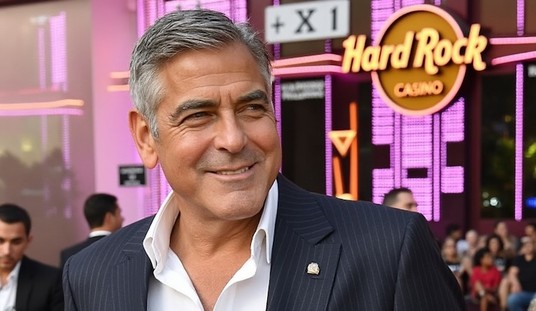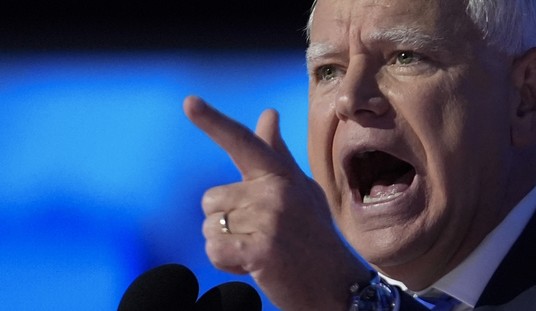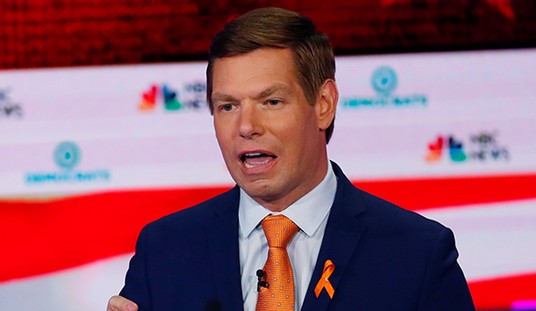Terry Teachout watches Ron Howard’s 1995 Apollo 13 film and ponders how much has changed in America since the epoch-defining NASA moon landings depicted in the movie. As he writes, “In the opening scene, we see a roomful of astronauts and their families celebrating in Houston as Neil Armstrong and Buzz Aldrin land on the moon. The TV that they’re watching is tuned to CBS, and Walter Cronkite, who was anchoring the network’s coverage of the flight of Apollo 11, makes no secret of his delight at the mission’s success. ‘Oh, boy!’ he cries in a tone that is not ‘objective’ but unabashedly admiring.”
There were very few issues that could have resonated approvingly with the perilously left-leaning Cronkite and pioneering libertarian Ayn Rand, but the Apollo program was one of them. Teachout adds that he also watched Cronkite on CBS as a “a thirteen-year-old boy unaware that he was witnessing a sea change in our national self-understanding:”
Having been a space buff throughout my childhood, it stood to reason that I should have been excited. But we were all on the same side on July 20, 1969, myself and my family and virtually the whole of America. Yes, the ties that bound us had been stretched to the breaking point by the assassinations of 1963 and 1968, and the Vietnam War was well on its way to snapping them. Yet we were still “we” on the night that Armstrong and Aldrin landed on the moon, just as we were “we” when, a few months later, the crew of Apollo 13 faced the imminent prospect of death in the silent chill of space. We believed in heroes then, just as we believed every word spoken on the air by Walter Cronkite, whose newscast my family watched each night after dinner.
This unanimity of national spirit is part of the point of Apollo 13, and I can’t help but wonder how it plays with younger viewers today, assuming they’ve seen the film. That’s not a safe assumption, seeing as how Apollo 13 was released in 1995. If you’re thirty years old, you weren’t yet born when Walter Cronkite retired, and you may well not even know his name, much less recognize his voice. You grew up in a very different country from the America of my youth, a land in which the phrase “common culture” was not in common use only because everybody took its existence for granted.
I’ve written a lot, here and elsewhere, about what it was like to grow up under the aspect of a common national culture. Now Charles Murray has published an extremely interesting essay in Commentary called “The United States of Diversity” in which he argues that America’s postwar cultural unanimity was an aberration from the historical norm:
Movies were ubiquitous by the beginning of World War I, and most American homes had a radio by the end of the 1920s. These new mass media introduced a nationally shared popular culture, and one to which almost all Americans were exposed. Given a list of the top movie stars, the top singers, and the top radio personalities, just about everybody younger than 60 would not only have recognized all their names but have been familiar with them and their work.
After the war, television spread the national popular culture even more pervasively. Television viewers had only a few channels to choose from, so everyone’s television-viewing overlapped with everyone else’s. Even if you didn’t watch, you were part of it—last night’s episode of I Love Lucy was a major source of conversation around the water cooler.
In these and many other ways, the cultural variations that had been so prominent at the time of World War I were less obvious by the time the 1960s rolled around. A few cities remained culturally distinct, and the different regions continued to have some different folkways, but only the South stood out as a part of the country that marched to a different drummer, and the foundation of that distinctiveness, the South’s version of racial segregation, had been cracked by the Civil Rights Act of 1964. In December 1964, Lyndon Johnson evoked his mentor Sam Rayburn’s dream, expressed in 1913, of an America “that knows no East, no West, no North, no South.” Johnson was giving voice to a sentiment that seemed not only an aspiration but something that the nation could achieve once the civil-rights movement’s triumph was complete….
Half a century after Johnson’s dream of a geographically and culturally homogeneous America, the United States is at least as culturally diverse as it was at the beginning of World War I and in some respects more thoroughly segregated than it has ever been. Today’s America is once again a patchwork of cultures that are different from one another and often in tension.
But in addition to looking back at the near-unanimous national approval of the moon landings in 1969 and ’70 even as the left’s culture war was about to accelerate to escape velocity, 1995’s Apollo 13 also reflects the era in which it was made. The Cold War was over — or at least undergoing an extended time out, and it was also concurrently a strange interregnum in the left’s culture war, when our “liberal” betters in Hollywood and in New York gave their enthusiastic blessings to an America that narrowly rejected moderate liberal George H.W. Bush and replaced him with moderate liberal Bill Clinton. As Jonah Goldberg has written, during that period David Brooks, then of the Weekly Standard and in the process of writing Bobos in Paradise happened to completely misread the tenor of the times in far left Burlington, Vermont during the Clinton era:
In his Weekly Standard article, entitled “The Rise of the Latte Town,” Brooks highlighted Burlington, Vermont as Exhibit A in what he identified as a profound transformation of American liberalism and American society in general. Brooks declared, “One of the striking things about Burlington is that it is relatively apolitical.” He noted how the bookstores downplayed overtly partisan books in favor of tomes which explained how individual citizens could help the homeless. “Bulletin boards are everywhere,” he reported, “but most of the fliers advertise rock bands, not rallies.” He saw only three political bumper stickers there: two simply said “Bernie” (a reference to Vermont’s only congressman, an Independent in the House and a socialist in his heart) and the third was a sticker for Rush–which he found on the outskirts of town on a pickup truck, so maybe the owner was an out-of-towner making a delivery.
All in all, Brooks discovered, Leftists didn’t care much about national or international politics. They wanted to be left with their expensive-but-necessary homes, cars, and clothes. “So these upscale liberals have retreated from national and urban politics and instead concentrated their energies on the local politics and small-scale activism to be found in the Latte Towns.” Moreover, while this retreat may be literal for those who voted with their feet and moved to Burlington, Austin, Texas, and Portland, Oregon, there has been a broader psychological retreat by the Left in general. “In this sense, Latte Towns represent a fundamental transformation in the American Left, the shift from the adversary culture to the alternative culture.”
Visiting Burlington in 2003 one discovers a very different Latte Town, and not just because Brooks seemed not to notice all of the drug addicts and facially pierced ne’er-do-wells. Oh, by the way, Latte Towns (Alan Ehrenhalt coined the term) are exactly what you’d think. I describe them in my forthcoming NRODT piece as one of those clever, crunchy, condescending college burgs crammed with students–and professors–with open-toed shoes and closed minds. The kids can name 50 different espresso drinks but not one reason to cut a tax, a tree, or their hair.
Anyway, Burlington is hardly the “apolitical” hamlet Brooks encountered. These days the bookstores front a lot more Noam Chomsky and Al Franken. You can still find flyers for bands–if you’re willing to peel off the ones advertising trips to Cuba. Political bumper stickers are everywhere. “Impeach Bush” is particularly popular, but my favorite was one I saw while driving along the campus of the University of Vermont: “The Road to Hell is Paved with Republicans.” You can also find it for sale at the “Peace & Justice Center & Store” on Church street in the heart of downtown Burlington.
So what changed? Well, some very important things have changed and others have stayed the same.
When Brooks visited Burlington, Bill Clinton was at the height of his popularity, just a couple of months before the Monica Lewinsky scandal broke. The ’90s economy was booming and for whatever reason liberals believed that, unlike the 1980s, Wall Street-generated “excess and greed” under a Democratic president were hunky-dory. If terrorists attacked, Leftists tended to blame America for forcing the delicate hands of peace-loving al Qaeda. And while most Leftists didn’t like it when we responded with force, at least President Clinton did so “proportionately” (refusing to highlight our military advantages too much, which might harm the self-esteem of backward countries and the leftists who infantilize them).
Now George W. Bush is president. And as numerous folks have noted, the Left hates George W. Bush. (See Jonathan Chait’s and Ramesh Ponnuru’s debate, for example.) President Bush doesn’t mind demonstrating that when it comes to things military the third world isn’t ready for adult swim. He cuts taxes. He talks funny–and not Garrison Keilor funny or Al Franken funny either. He mentions God in a non-kitschy way without using quotation marks or a lowercase “q.” You get it. The fact is upscale and downscale liberals alike loathe the man.
And, like the savages who riot when you leave the toilet seat up, they have no problem making that known. I flatly refuse to believe that if Brooks visited Burlington today–or any other Latte Town–he would still think the locals are “apolitical.”
On the other side of the country during the 1990s, Hollywood rode out that era making films that celebrated America’s achievements (as in the case of Apollo 13, which if I’m remembering it correctly, contains only one churlish comment about Richard Nixon) and portraying that decade’s American president as a heroic man of action. In 1997, Nick Gillespie of Reason surveyed the glut of Hollywood’s pro-POTUS product and concluded:
Why the filmic landslide? Director Ivan Reitman, who shot 1993’s Dave, chalks it up to baby boomer solidarity, telling Time that Clinton “is just like me….He’s my age. There are a lot of commonalities.” That might explain the sympathetic portrayals, but it fails to account for the sheer quantity (or the nasty takes). Part of the reason lies with those election results: Without a clear mandate, both supporters and detractors are more likely to go on the offensive. Then there’s the chief executive’s well-known penchant to be all things to all people. That may not be possible in Washington, but judging from the presidential filmography to date, it’s a dream come true in Hollywood.
There were two films of that era that in retrospect are particularly of note: 1997’s Air Force One, which starred Harrison Ford as a 50-something American president who knew his way around the cockpit of a jet aircraft, refused to take any guff from terrorists, and had a woman as a vice president to boot. And 1999’s Three Kings, which starred George Clooney, and denigrated George H.W. Bush for not toppling Saddam Hussein in Iraq.
No wonder Hollywood has been so miserable after 9/11; they got everything they has previously wished for in a president and as a result, thoroughly hated his guts.










Join the conversation as a VIP Member